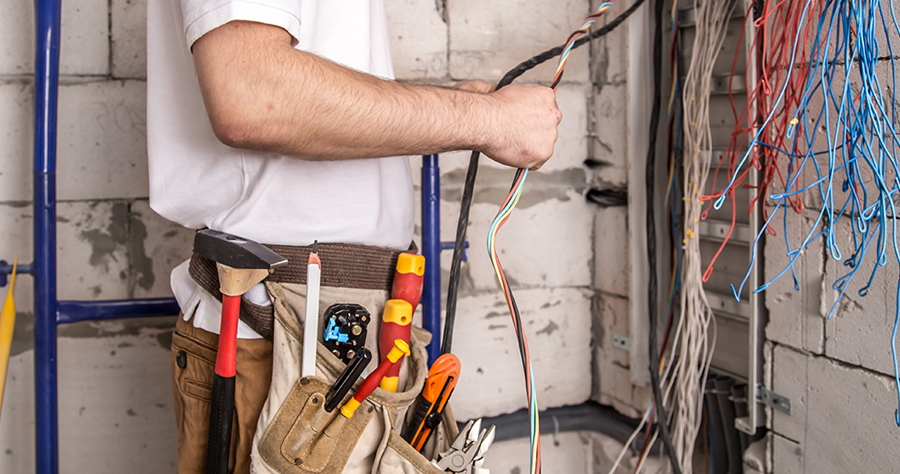
For a house is a critical step in the construction or renovation process, ensuring that the electrical system meets the needs of the occupants while adhering to safety standards and regulations. In this guide, we’ll explore the essential steps and considerations involved in estimating electrical wiring for a house, from assessing electrical needs to creating a wiring plan and budgeting for materials and labor.
I. Introduction to Estimating Electrical Wiring
A. Importance of accurate electrical wiring estimates
Accurate electrical wiring estimates are essential for budgeting, planning, and ensuring the safety and functionality of the electrical system. Underestimating or overestimating wiring needs can lead to cost overruns, project delays, and safety hazards.
B. Understanding the scope of electrical wiring projects
Electrical wiring projects encompass a wide range of tasks, including planning circuits, selecting materials, routing wiring paths, and installing outlets, switches, and fixtures. Understanding the scope of the project is crucial for accurate estimation.
C. Overview of the estimation process
The estimation process involves assessing electrical needs, creating a wiring plan, estimating material quantities, pricing materials and labor, and finalizing the estimate. Attention to detail and thorough planning are essential for success.
II. Assessing Electrical Needs and Requirements
A. Determining the electrical load
- Calculating power requirements for appliances and devices: Assess the power needs of appliances and devices to determine the overall electrical load for the house.
- Considering future expansion and usage patterns: Anticipate future needs and usage patterns to accommodate potential expansions or upgrades to the electrical system.
- Consulting electrical codes and regulations: Refer to local building codes and regulations to ensure compliance with safety standards and requirements.
B. Identifying circuit requirements
- Allocating circuits for different areas and appliances: Divide the electrical load into circuits, allocating separate circuits for different areas and high-power appliances.
- Factoring in safety considerations and load balancing: Ensure proper load balancing and safety by distributing circuits evenly and avoiding overloading.
- Planning for specialized circuits: Allocate dedicated circuits for high-power appliances such as refrigerators, air conditioners, and laundry equipment.
C. Selecting wiring materials and components
- Choosing appropriate wire gauges and types: Select wire gauges and types based on the electrical load, circuit requirements, and environmental conditions.
- Selecting outlets, switches, and other electrical components: Choose outlets, switches, and fixtures that meet safety standards and complement the design and functionality of the space.
- Ensuring compliance with local building codes: Verify that selected materials and components comply with local building codes and standards for safety and performance.
III. Creating a Wiring Plan and Layout
A. Sketching the house layout
- Mapping out the floor plan and room layout: Sketch the floor plan and layout of the house, including the placement of rooms, walls, doors, and windows.
- Identifying key areas for electrical outlets: Determine the locations for electrical outlets, switches, and fixtures based on usage patterns and convenience.
- Considering accessibility and convenience: Ensure that outlets and switches are easily accessible and conveniently located for occupants.
B. Designing the electrical circuits
- Planning the routing of wiring paths and conduits: Design the routing of wiring paths and conduits to minimize visibility and maximize efficiency.
- Allocating circuits to minimize voltage drop: Divide circuits strategically to minimize voltage drop and ensure consistent power distribution.
- Incorporating safety features: Incorporate safety features such as ground fault circuit interrupters (GFCIs) and arc fault circuit interrupters (AFCIs) to protect against electrical hazards.
C. Estimating material quantities
- Calculating the lengths of wiring runs: Measure the lengths of wiring runs and conduits required for each circuit, accounting for the layout and dimensions of the house.
- Estimating the number of outlets, switches, and fixtures: Determine the quantity of outlets, switches, and fixtures needed for each room and area based on usage and requirements.
- Accounting for waste and contingencies: Add allowances for waste, extra materials, and contingencies to account for unexpected changes or adjustments during installation.
IV. Cost Estimation and Budgeting
A. Pricing electrical materials and labor
- Researching current prices for wiring materials: Research current prices for wiring materials, outlets, switches, and fixtures from multiple suppliers and retailers.
- Obtaining quotes from electrical suppliers and contractors: Request quotes from electrical suppliers and contractors for materials and labor costs based on the wiring plan and project specifications.
- Factoring in labor costs: Consider labor costs for installation, wiring, and electrical work based on project complexity, duration, and scope.
B. Creating a comprehensive budget
- Summarizing material and labor costs: Compile material and labor costs for wiring materials, outlets, switches, fixtures, and labor into a comprehensive budget.
- Allocating funds for unforeseen expenses: Set aside funds for unforeseen expenses, changes, or contingencies that may arise during the project.
- Reviewing the budget: Review the budget to ensure accuracy and feasibility, making adjustments as needed to align with project goals and constraints.
V. Refining the Estimate and Finalizing Plans
A. Reviewing and revising the wiring plan
- Conducting a thorough review of the wiring layout: Review the wiring plan and layout for accuracy, completeness, and compliance with codes and regulations.
- Incorporating feedback from electrical professionals: Seek feedback and input from electrical professionals, contractors, or consultants to identify areas for improvement or optimization.
- Making adjustments to optimize efficiency: Make adjustments to the wiring plan and layout to optimize efficiency, performance, and cost-effectiveness.
B. Finalizing the electrical wiring estimate
- Documenting the final wiring plan and material list: Document the final wiring plan, layout, and material list in a comprehensive document or report for reference and documentation.
- Double-checking calculations and quantities: Double-check calculations and quantities for accuracy, ensuring that all materials and components are accounted for.
- Presenting the estimate to clients or project stakeholders: Present the final electrical wiring estimate to clients or project stakeholders for review, approval, and implementation.
In conclusion, estimating electrical wiring for a house requires careful planning, attention to detail, and adherence to safety standards and regulations. By assessing electrical needs, creating a wiring plan, budgeting for materials and labor, and refining the estimate based on feedback and input, homeowners and contractors can ensure a successful and cost-effective electrical wiring project.






